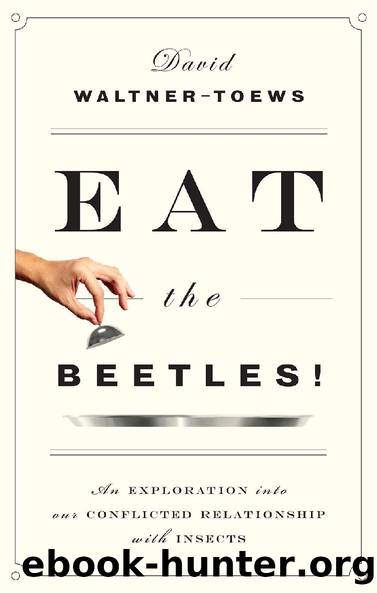Eat the Beetles! by David Waltner-Toews

Author:David Waltner-Toews
Language: eng
Format: epub
Tags: Copyright © David Waltner-Toews, 2017
Publisher: ECW Press
Published: 2017-05-09T00:00:00+00:00
SHE CAME IN THROUGH THE KITCHEN WINDOW
Culinary Renewal from the Margins
Cool stink bug cream and a nice weevil tart,
I feel your taste all the time we’re apart
Southeast Asia, as many YouTube videos and enthusiastic travelers will tell you, offers a veritable buffet of insectivorism and seems to be at the forefront of linking the cuisines of insect-eating and non-insect-eating cultures.
Introduced into Thailand in 1988 based on technology developed by Khon Kaen University, cricket farming and demands for its products in Thailand and beyond have exceeded even the most optimistic expectations. By 2011, twenty thousand Thai cricket farmers were putting out more than seven tons annually. Schools had introduced programs to fortify school lunches. The highest input costs were feed-related. Many were giving the crickets chicken feed, although vegetables such as pumpkins, cassava, morning glory leaves, and watermelon were often fed just before harvest to improve taste.
In neighboring Lao PDR, cricket farming has been slower to commercialize, and has only been around since the early aughts. Nevertheless, various ethnic groups in the region have been eating insects for a long time. Even now, although under duress to give up their “primitive” habits by television-inspired globalization, some 95 percent of Laotians are reported to eat insects of one sort or another. The surviving entomophagical practices include, for people living near water such as a paddy field, scavenging for diving beetles, water scavenger beetles, water scorpions, giant water bugs, stink bugs, and dragonfly larvae. In the dry season, people eat the larvae and adults of dung beetles. Stink bugs are sold fried or live to be prepared at home. Cooks remove the stink by boiling them, and then make them into a paste to be eaten as a side dish. People in South Africa, Malawi, Papua New Guinea, and Mexico also eat stink bugs.
In August of 2015, Thomas Weigel (the cricket project manager for VWB/VSF) took me to the Dong Makkhai market, just outside of Vientiane, where the vendors sell a variety of products foraged from Laotian forests. One of the authors included in Forest Insects as Food: Humans Bite Back reported that “among the edible insects [at the Dong Makkhai Market] the biggest sellers are weaver ant eggs (23 percent), grasshoppers (23 percent), crickets (13 percent), honeycombs (13 percent), wasps (9 percent), cicadas (5 percent) and honey bees (5 percent). The highest price is paid for young cicadas — about US$25/kilogram.”
The foods Thomas and I saw on display in the market were as stunningly diverse as the reports indicated. Heaped on the display tables were mushrooms, seeds, frogs, turtles, honey laced with some kind of bitter, medicinal plant product (passably okay, I discovered later, with Nutella), and a wide variety of six-legged wildlife — different sizes of grasshoppers, small white crickets, house crickets, mole crickets, wasps, wasp eggs and larvae, dragonflies, and dung beetles. Many of these were already roasted or fried, but in a few cases live crickets were on display, freshness assured by their scrabbling attempts to escape their deep plastic bowls, resident flies circling the rims.
Download
This site does not store any files on its server. We only index and link to content provided by other sites. Please contact the content providers to delete copyright contents if any and email us, we'll remove relevant links or contents immediately.
| Cell Biology | Developmental Biology |
| Entomology | Marine Biology |
| Microbiology | Molecular Biology |
| Biostatistics |
Sapiens: A Brief History of Humankind by Yuval Noah Harari(13051)
The Tidewater Tales by John Barth(12029)
Do No Harm Stories of Life, Death and Brain Surgery by Henry Marsh(6336)
Mastermind: How to Think Like Sherlock Holmes by Maria Konnikova(6234)
The Thirst by Nesbo Jo(5785)
Why We Sleep: Unlocking the Power of Sleep and Dreams by Matthew Walker(5640)
Sapiens by Yuval Noah Harari(4535)
Life 3.0: Being Human in the Age of Artificial Intelligence by Tegmark Max(4506)
The Longevity Diet by Valter Longo(4445)
The Rules Do Not Apply by Ariel Levy(3905)
The Immortal Life of Henrietta Lacks by Rebecca Skloot(3826)
The Body: A Guide for Occupants by Bill Bryson(3799)
Why We Sleep by Matthew Walker(3771)
Animal Frequency by Melissa Alvarez(3754)
Yoga Anatomy by Kaminoff Leslie(3701)
Barron's AP Biology by Goldberg M.S. Deborah T(3631)
The Hacking of the American Mind by Robert H. Lustig(3579)
All Creatures Great and Small by James Herriot(3515)
Yoga Anatomy by Leslie Kaminoff & Amy Matthews(3394)
